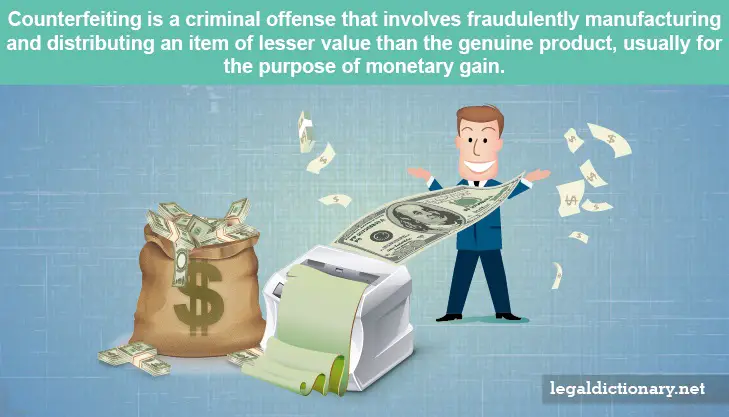Counterfeiting
Counterfeiting is a criminal offense that involves fraudulently manufacturing and distributing an item of lesser value than the genuine product, usually for the purpose of monetary gain. Counterfeiting is commonly seen in the form of counterfeiting money, including currency and coins, but also involves the fraudulent production of copies of valuable digital media, such as CDs and DVDs, as well as designer clothing, jewelry, and accessories. The production, distribution, and sale of counterfeit items not only defrauds those buying the items, but also steals profits from the owners and distributors of the genuine articles. To explore this concept, consider the following counterfeiting definition.
Definition of Counterfeiting
- verb. The act of making something in an imitation so good as to be fraudulently or deceptively put forth as the genuine article.
Origin 1250-1300 Middle English countrefet (false, or forged)
What is Counterfeiting
Counterfeiting is the practice of manufacturing items that look like, but are substantially inferior to, a brand name or genuine item. Counterfeit goods are commonly marketed with a brand or trade name without consent by the brand’s owner. These goods usually bear a trademark that is identical, or “forged,” or that is so similar as to make it nearly impossible to tell it from the real thing. The manufacturing of counterfeit goods has become commonplace in many developing countries that have a large, underpaid workforce. The goods, however, are shipped and sold worldwide.
Counterfeiting is considered a crime in almost all countries around the globe, with penalties ranging anywhere from injunctions and fines, to big money damages and imprisonment. Counterfeiting, in all of its forms, is considered theft, and nations around the world cooperate together in the attempt to put a stop to it.
Counterfeiting Money
The idea of counterfeiting money is as old as the use of currency itself, though modern technology has made the process seemingly easier for tech-savvy entrepreneurs. The temptation of being able to print money and buy anything the heart desires is irresistible for some people, who never consider the fact that the U.S. economy might be vulnerable to collapse under a deluge of counterfeit bills.
The increase in numbers of people trying their hands at counterfeiting money has sent the U.S. Treasury into making a flurry of anti-counterfeiting changes to the nation’s currency. Such anti-counterfeiting technology includes the production of multi-colored bills printed on special fabric-based paper, holograms, embedded magnetic strips, micro printing, watermarks, and the inclusion of the “EURion constellation,” also called “Omron rings,” which prevent color photocopiers from printing banknotes.
While counterfeiting expands its scope from printing money, to manufacturing counterfeit clothing and other apparel, to electronics, and even medications, anti-counterfeiting technology strains to keep up with its pace.
Software Counterfeiting
Software counterfeiting involves the sale of illegally made copies of computer software programs. These copies are usually made to appear as an original, but there are definitely differences in how the counterfeited software will function. To combat the widespread problem of software counterfeiting, manufacturers of popular programs and operating systems have started relying on live internet registration and updates. During this process, the individual installing the program must log onto the internet and enter a validation code, which is paired with the computer’s ID, and kept on file. If, at any time, someone tries to register the software on a different computer using the same validation code, access will be denied unless the software on the original computer is first disabled, once again, online.
Trademark Counterfeiting
Trademark counterfeiting refers to the placing of a company’s actual registered trademark on a product or service that is not legitimate, and without the permission of the trademark owner. One example is the placement of a Louis Vuitton or Gucci trademarked logo on knock-off handbags, and selling them for substantially less than the genuine items. Trademark counterfeiting strikes a blow to companies the world over to the tune of millions of dollars every year, and, while anti-counterfeiting technology is widely used to prevent manufacture of counterfeit money and software, trademark counterfeiting remains more difficult to prevent.
In the United States, trademark counterfeiting is specifically prohibited by the Trademark Counterfeiting Act of 1984, which makes it a federal offense to intentionally use a counterfeit trademark. The Act also establishes tougher penalties in the form of fines up to $1 million, and imprisonment of up to five years for selling, or even attempting to sell, counterfeit goods or services.
Related Legal Terms and Issues
- Criminal Offense – An act in violation of the law which causes, or has the potential to cause, injury to the public, or a member of the public, and for which a fine and/or imprisonment are possible penalties.
- Registered Trademark – A distinctive symbol or mark to which an individual or entity has claimed ownership by registering the trademark with the U.S. Patent and Trademark Office.
